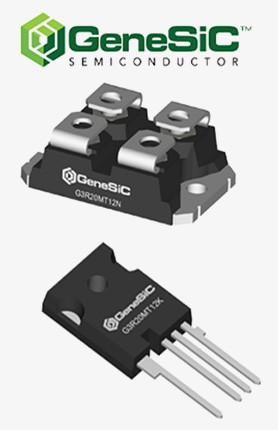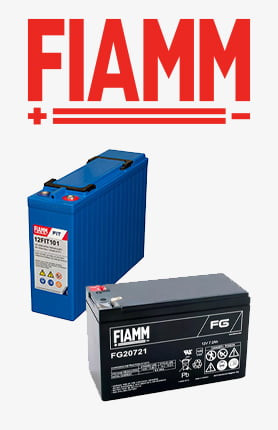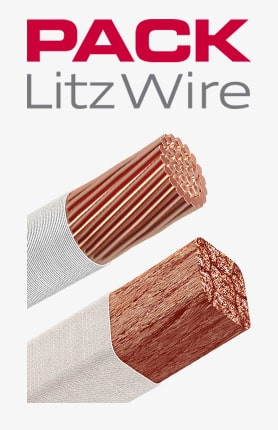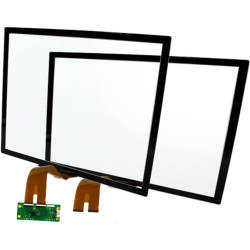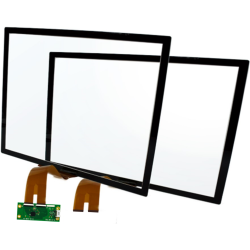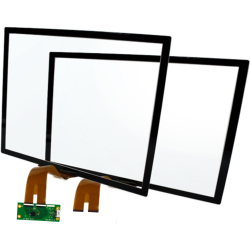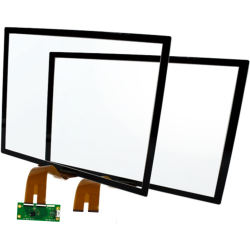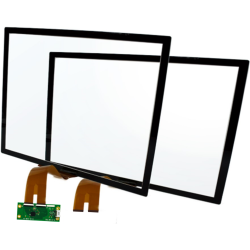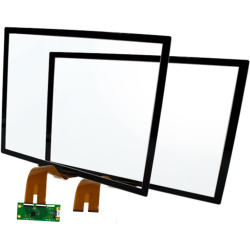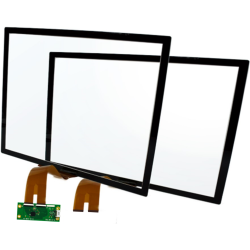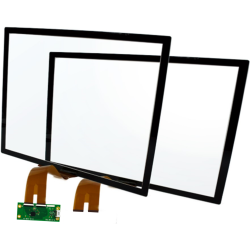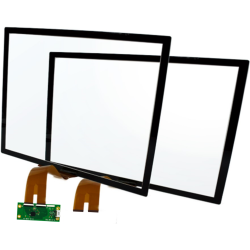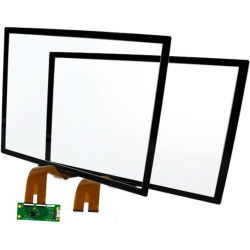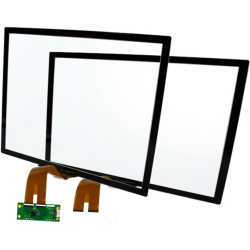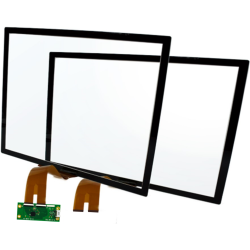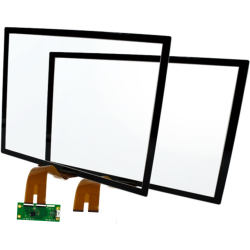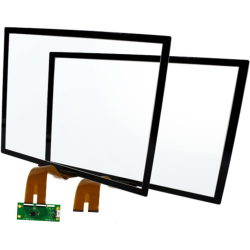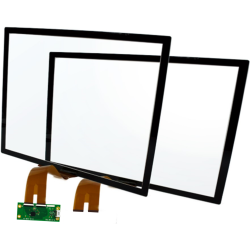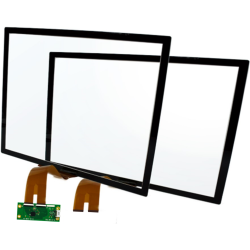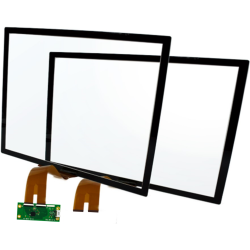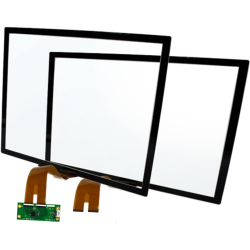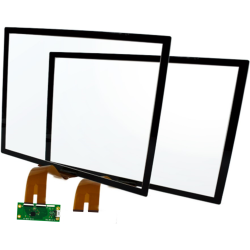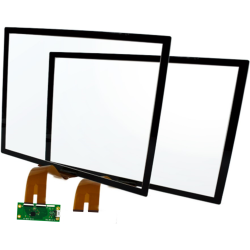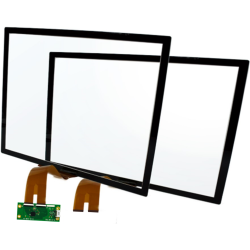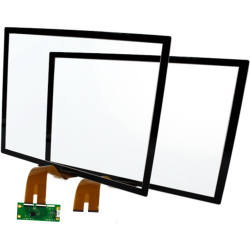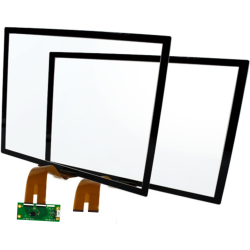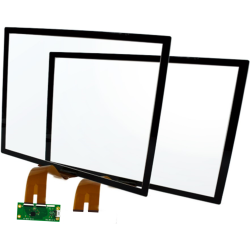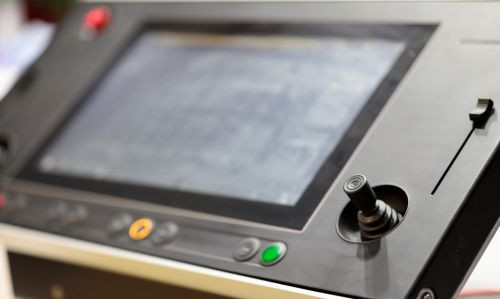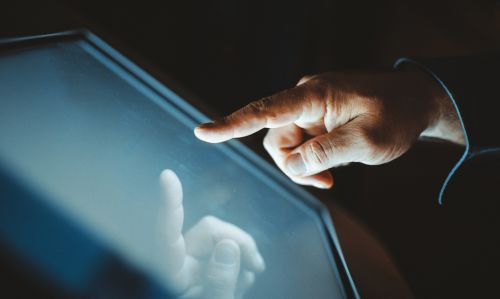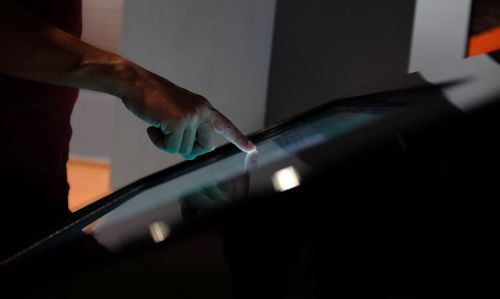Capacitive touch screens
Capacitive touchscreens (PCAP – Projected Capacitive Touch) are a modern technology that has gained popularity in HMI (Human-Machine Interface) systems, multimedia devices, and points of sale. Unlike traditional resistive screens, PCAP responds to changes in the electrostatic field caused by a finger or conductive stylus touch, allowing precise operation and multi-touch features, such as zooming, panning, or rotating elements on the screen.
Definition of PCAP technology
Capacitive technology is based on projecting an electric field in a thin layer of screen glass. Touching the screen with a finger disturbs the local electrostatic field, allowing the control system to determine the exact coordinates of the touch point. Due to this principle, PCAP screens offer high sensitivity and accuracy even with minimal pressure, which distinguishes them from resistive screens that require physical pressure on conductive layers.
Differences compared to resistive screens
- Touch detection method: PCAP detects touch through electrical conductivity, while resistive screens operate based on the pressure of two conductive layers.
- Multi-touch and gestures: Capacitive screens allow multiple touch points simultaneously, enabling gestures like pinch, swipe, or rotate. Standard resistive screens typically offer only single-point or limited two-point functionality.
- Aesthetics and clarity: PCAP allows the use of thin glass with high transparency and anti-reflective coatings, enhancing user comfort and the visual appeal of devices.
- Environmental sensitivity: Capacitive screens are less resistant to moisture and dirt compared to resistive ones but gain in gesture handling and interactivity.
Popularity and role in modern HMI systems
Capacitive screens have become the standard in interactive control panels, self-service kiosks, multimedia devices, and POS terminals. Their precision, responsiveness, and sleek appearance make them indispensable in environments where high aesthetics, user comfort, and multi-touch gesture support are important. In HMI systems, PCAP enables faster operator interaction with machines, intuitive process control, and efficient use of graphical interfaces.
Due to these features, capacitive touchscreens offered by DACPOL provide an ideal solution for users seeking modern, aesthetic, and functional touch panels in commercial, industrial, and multimedia applications.
Types of capacitive screens
DACPOL offers a wide range of capacitive (PCAP) screens combining touch precision, aesthetics, and modern multi-touch features. The variety of available models allows for adapting the solution to the requirements of industrial, commercial, multimedia, and interactive HMI systems.
Standard PCAP screens
Standard capacitive screens use a thin glass layer with a conductive matrix that responds to a finger or conductive stylus touch. Their main features include:
- High accuracy even with minimal pressure.
- Multi-touch support, enabling gestures such as pinch, swipe, or rotate.
- Thin and lightweight design ideal for control panels, information kiosks, and mobile devices.
Standard PCAP screens perform well in office environments as well as public applications where interactivity and screen responsiveness are crucial.
Protective coatings and aesthetics
DACPOL capacitive screens can be equipped with advanced protective coatings that enhance durability and user comfort:
- AG Cover Glass (Anti-Glare) – minimizes reflections, improves visibility in sunlight, and provides an attractive appearance.
- Anti-fingerprint coating – reduces fingerprints, facilitates screen cleaning, and maintains high display clarity.
These coatings combine functionality with elegant design, making PCAP screens ideal for points of sale, informational terminals, and modern control panels.
Multi-touch screens and advanced gesture features
Advanced PCAP models offer full multi-touch gesture support, enabling intuitive interaction with graphical interfaces. These features enhance user comfort and operational efficiency for operators and end-users.
Key capabilities include:
- Recognition of multiple simultaneous touch points.
- Gestures for zooming, panning, rotating, and moving elements.
- Integration with interactive HMI systems, multimedia panels, and self-service kiosks.
DACPOL capacitive screens combine modern touch technology with durability and elegant design, allowing the creation of intuitive and visually appealing interfaces in commercial, industrial, and educational applications.
Advantages and features of capacitive screens
Capacitive screens (PCAP) offered by DACPOL stand out for their modern touch technology, combining precision, aesthetics, and durability. These qualities make them an ideal solution for HMI applications, interactive kiosks, POS terminals, and multimedia devices.
Touch precision and responsiveness
PCAP screens respond to minimal finger or conductive stylus touch, providing instant and accurate detection. This allows operators and end-users to perform precise actions, with the interface responding smoothly to every gesture. High responsiveness makes capacitive screens ideal for dynamic work environments where quick and reliable reactions are essential.
Multi-touch and gesture support
Advanced PCAP models support multiple simultaneous touch points, enabling multi-touch functions and gestures such as:
- Pinch – zooming in and out.
- Swipe – moving interface elements.
- Rotate – rotating objects on the screen.
These capabilities enhance usability, allow the creation of interactive control panels, and provide comfort in points of sale, multimedia systems, and informational terminals.
Aesthetics and protective coatings
DACPOL capacitive screens are not only functional but also elegant and durable. Protective coatings improve appearance and user convenience:
- AG Cover Glass (Anti-Glare) – reduces reflections and improves screen readability in daylight.
- Anti-fingerprint – minimizes fingerprints, keeping the display clean and clear.
These features make PCAP screens suitable for modern, aesthetic, and interactive applications.
Mechanical durability and everyday resilience
Although capacitive screens are thin and lightweight, their protective glass surface provides high resistance to scratches and daily mechanical wear. This ensures devices with PCAP maintain functionality and appearance for a long time, even in heavily used locations such as self-service kiosks, points of sale, or multimedia terminals.
Capacitive screen features
DACPOL capacitive screens (PCAP) not only provide precise touch control but also include solutions enhancing durability, aesthetics, and user comfort. These specialized features make them ideal for applications requiring both functionality and an elegant appearance.
Scratch and mechanical damage resistance
PCAP screens are made of high-strength tempered glass, ensuring resistance to daily mechanical damage, scratches, and minor impacts. This allows devices to remain functional even in high-traffic points of sale, self-service kiosks, or interactive multimedia panels.
Anti-fingerprint and anti-glare coatings
Additional protective coatings enhance usability and aesthetics:
- Anti-fingerprint – minimizes fingerprints and dirt, facilitating cleaning and improving display readability.
- Anti-glare (AG Cover Glass) – reduces reflections and glare, ensuring good screen visibility in bright lighting conditions, including outdoor or public spaces.
Integration in multimedia devices and interactive systems
Thanks to their thin design and high precision, PCAP capacitive screens are easily integrated into modern multimedia systems and interactive control panels. This allows the creation of elegant, intuitive interfaces in:
- information kiosks and points of sale,
- POS terminals and ticketing machines,
- educational and multimedia systems,
- mobile devices and interactive touch tables.
The specialized features of PCAP screens combine mechanical durability, ease of use, and aesthetics, making them an ideal choice for modern and demanding applications.
Applications of capacitive screens
Capacitive screens (PCAP) are increasingly popular due to their touch precision, multi-touch support, and modern aesthetics. Their versatility makes them suitable for various industries and device types, including commercial, educational, and industrial applications.
Points of sale, kiosks, ATMs, and reservation systems
PCAP screens are an ideal choice for public-use devices. Multi-touch, gestures, and high responsiveness improve user comfort and speed up customer service. Typical applications include:
- POS terminals in stores and restaurants,
- self-service kiosks in shopping centers,
- ATMs and payment machines,
- ticket or service reservation systems.
In these applications, aesthetics and protective coatings (anti-fingerprint, AG Cover Glass) enhance service quality and device durability in high-traffic areas.
Multimedia devices and interactive control panels
PCAP performs well in interactive multimedia systems where responsiveness and precision are essential. Capacitive screens are used in:
- interactive touch tables and control panels,
- exhibition and information systems in museums or galleries,
- modern educational and demonstration panels in schools and universities.
Multi-touch enables intuitive gestures like panning, zooming, and rotating, enhancing interactivity and the attractiveness of presented content.
Educational, business, and office applications
In educational and office environments, capacitive screens are used for collaborative work, multimedia presentations, and interactive learning. Thanks to scratch resistance and aesthetic finishing:
- they support effective training and presentations in companies,
- enable the creation of digital whiteboards and interactive displays in schools and universities,
- are used in conference rooms and information points in businesses.
PCAP screens combine functionality, durability, and modern appearance, making them ideal for commercial, educational, and multimedia applications.
Choosing the right capacitive screen
Selecting the right capacitive screen (PCAP) requires considering several key criteria affecting user comfort, device durability, and aesthetics. With a wide range of available models, it is possible to match the screen to specific business, educational, multimedia, or public needs.
PCAP screen selection criteria
1. Touch precision and responsiveness
High screen sensitivity is essential in applications requiring fast and accurate operation. Precise touch detection improves user comfort, minimizes errors, and increases efficiency in commercial and educational environments.
2. Multi-touch and gesture support
Multi-touch functions allow intuitive gestures such as zooming, panning, and rotating objects. This criterion is critical in interactive kiosks, control panels, and multimedia devices where natural and ergonomic content control is required.
3. Aesthetics and protective coatings
Using AG Cover Glass and anti-fingerprint coatings improves image clarity, reduces fingerprints, and increases resistance to daily dirt. These screens stand out with their elegant appearance, important in points of sale, offices, and public spaces.
4. Mechanical durability and everyday resilience
Depending on the application environment, it is important to consider surface strength and scratch resistance. PCAP screens with durable protective glass guarantee long-lasting functionality even in heavily used devices.
Standard versions vs. screens with protective coatings
- Standard PCAP screens – offer high touch precision and multi-touch support. Suitable for indoor applications where external factors and dirt are not significant threats.
- PCAP screens with protective coatings – equipped with AG Cover Glass, anti-fingerprint, or anti-glare coatings, designed for high-traffic environments exposed to scratches and dirt. Ideal for kiosks, points of sale, multimedia devices, and interactive control panels.
Summary and recommendations for capacitive screens
Capacitive touchscreens (PCAP) are modern, precise, and aesthetic solutions, ideal for interactive HMI systems, multimedia devices, and customer service points. Their advantages stem from high responsiveness, multi-touch gesture support, and advanced protective coatings that enhance durability and user comfort.
Why choose capacitive screens
- Precision and responsiveness – capacitive technology enables accurate and fast touch recognition, ensuring comfort and efficiency in daily use.
- Multi-touch and gesture support – allows natural interaction, zooming, panning, and rotating elements, which is crucial in interactive control panels and educational devices.
- Aesthetics and protective coatings – AG Cover Glass and anti-fingerprint and anti-glare coatings ensure durability, reduce fingerprints, and improve visibility in various lighting conditions.
- Mechanical durability and everyday resilience – PCAP screens are resistant to scratches and daily wear, ensuring long-lasting and trouble-free use.
With high precision, durability, and functionality, capacitive screens are the optimal choice in places where user comfort, interactivity, and modern design matter. Choosing a PCAP screen is an investment in a reliable, durable, and modern touch solution that meets expectations in business, educational, and multimedia environments.

